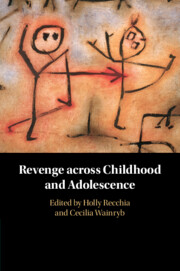Book contents
- Revenge across Childhood and Adolescence
- Revenge across Childhood and Adolescence
- Copyright page
- Dedication
- Contents
- Figures
- Tables
- Contributors
- Acknowledgments
- Chapter 1 And If You Wrong Us, Shall We Not Revenge?
- Chapter 2 A Framework for Understanding Variation in Youth Revenge Motivations and Retaliatory Behaviors
- Chapter 3 Normative Changes and Individual Differences in Retaliation Judgments
- Chapter 4 Developing Revenge in Early Childhood
- Chapter 5 Understanding Youths’ Retaliatory Experiences through the Lens of Moral Agency
- Chapter 6 Cultural Systems and the Development of Norms Governing Revenge and Retribution
- Chapter 7 Settling the Score in a Zero-Sum Game
- Chapter 8 Intergroup Processes
- Chapter 9 Revenge, Justice Systems, and Institutional Trust in Schools
- Chapter 10 The Importance of a Positive School Climate in Addressing Youth Retaliation
- Chapter 11 Socioemotional Competencies and Positive Classroom Climate as Alternatives to Prevent Revenge in Colombian Schools
- Chapter 12 Looking Back and Charting a Course
- Index
- References
Chapter 12 - Looking Back and Charting a Course
Considering Individual, Interpersonal, and Institutional Contributions to the Development of Revenge in Childhood and Adolescence
Published online by Cambridge University Press: 08 July 2021
- Revenge across Childhood and Adolescence
- Revenge across Childhood and Adolescence
- Copyright page
- Dedication
- Contents
- Figures
- Tables
- Contributors
- Acknowledgments
- Chapter 1 And If You Wrong Us, Shall We Not Revenge?
- Chapter 2 A Framework for Understanding Variation in Youth Revenge Motivations and Retaliatory Behaviors
- Chapter 3 Normative Changes and Individual Differences in Retaliation Judgments
- Chapter 4 Developing Revenge in Early Childhood
- Chapter 5 Understanding Youths’ Retaliatory Experiences through the Lens of Moral Agency
- Chapter 6 Cultural Systems and the Development of Norms Governing Revenge and Retribution
- Chapter 7 Settling the Score in a Zero-Sum Game
- Chapter 8 Intergroup Processes
- Chapter 9 Revenge, Justice Systems, and Institutional Trust in Schools
- Chapter 10 The Importance of a Positive School Climate in Addressing Youth Retaliation
- Chapter 11 Socioemotional Competencies and Positive Classroom Climate as Alternatives to Prevent Revenge in Colombian Schools
- Chapter 12 Looking Back and Charting a Course
- Index
- References
Summary
In this integrative chapter, we summarize insights emerging from the volume as a whole with respect to the main propositions outlined in the introduction, namely, that (a) revenge is part and parcel of children’s and adolescents’ lives, manifesting various normative forms and functions, and (b) throughout childhood and adolescence, revenge can be both a consequence and a predictor of adverse psychological and social processes. In addressing the ways in which these two overarching concerns are woven throughout the chapters in this book, we summarize the contributions of individual, interpersonal, and institutional-level influences on the development of revenge. We conclude with proposed future directions and implications for intervention.
Keywords
- Type
- Chapter
- Information
- Revenge across Childhood and Adolescence , pp. 298 - 313Publisher: Cambridge University PressPrint publication year: 2021



